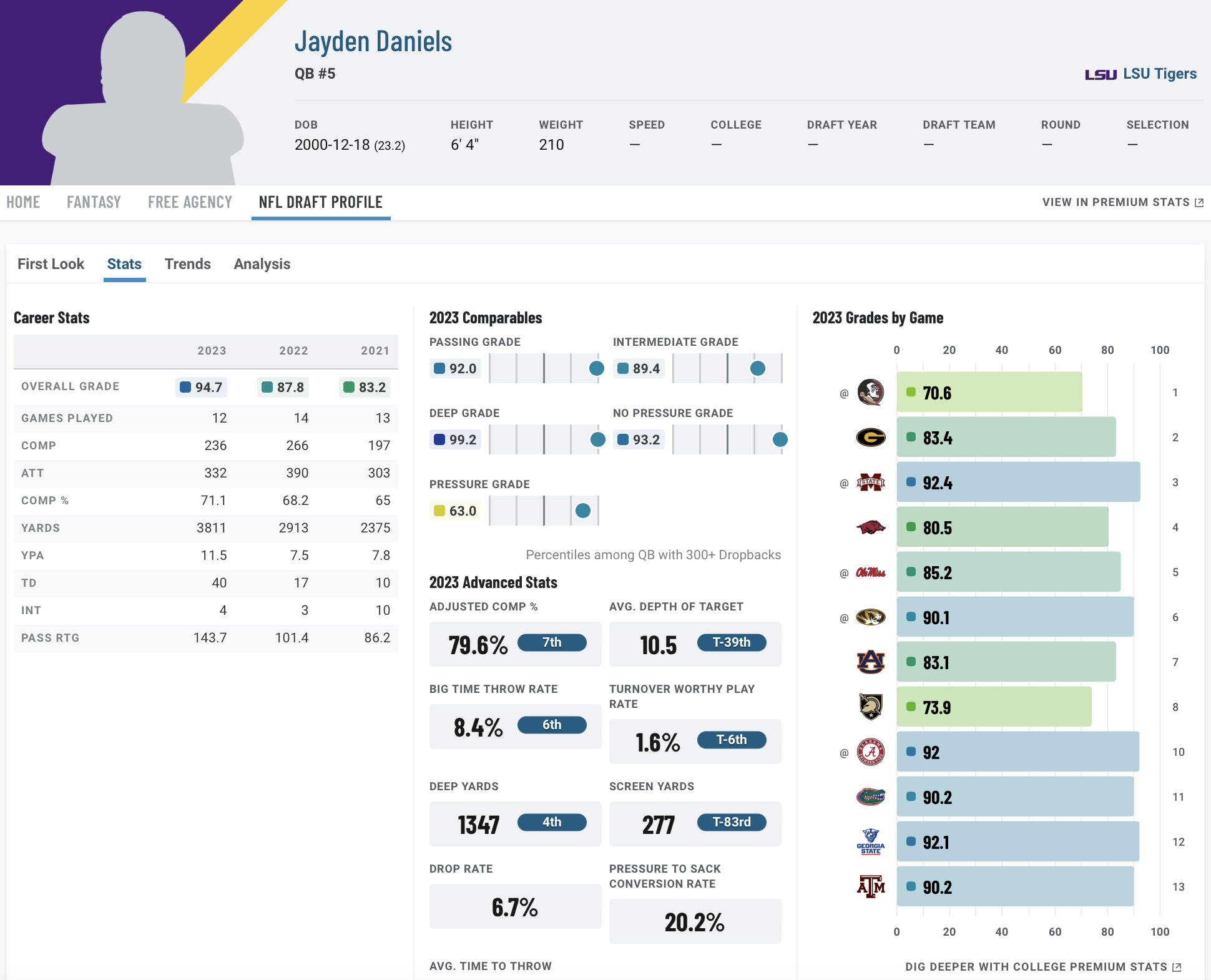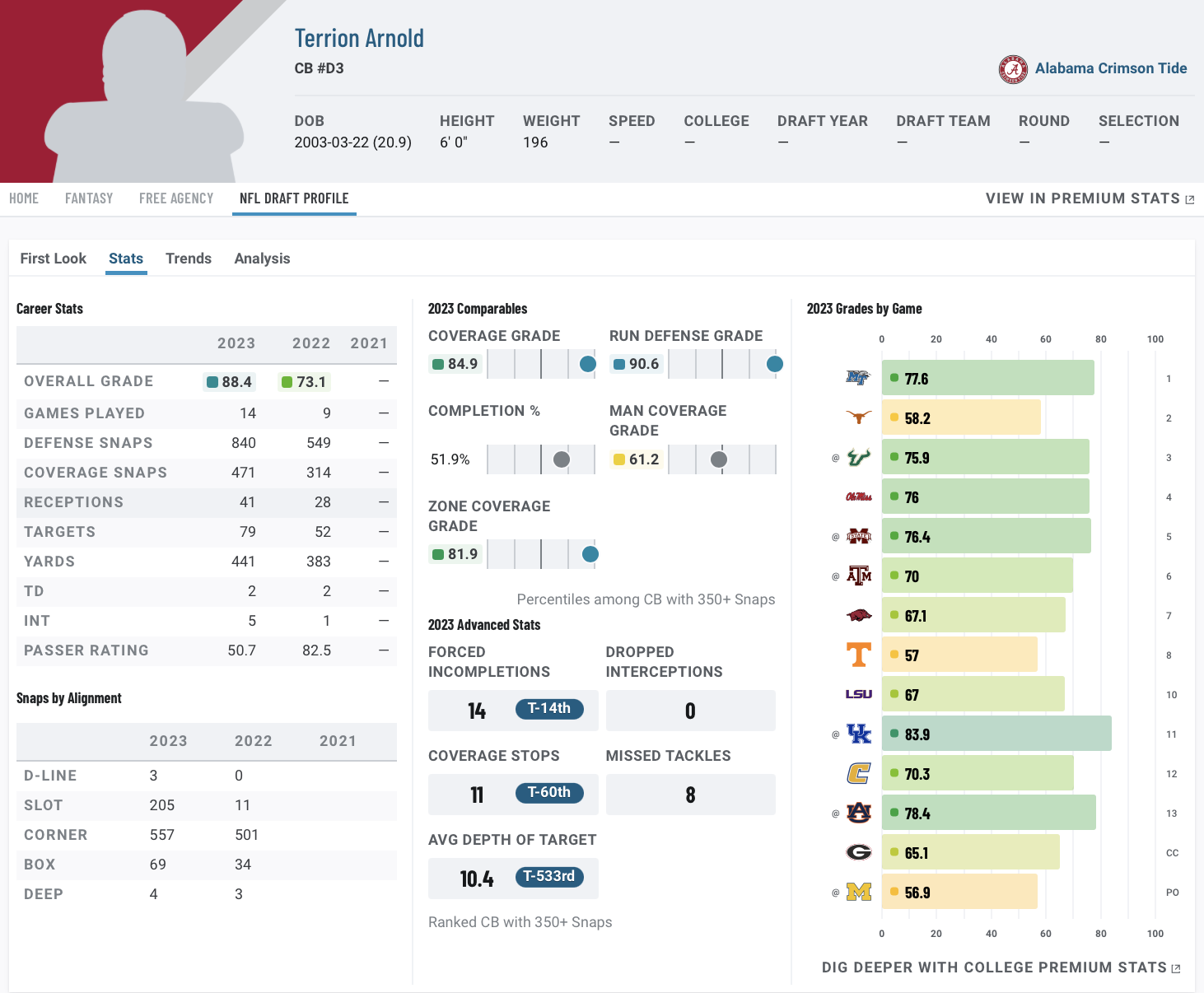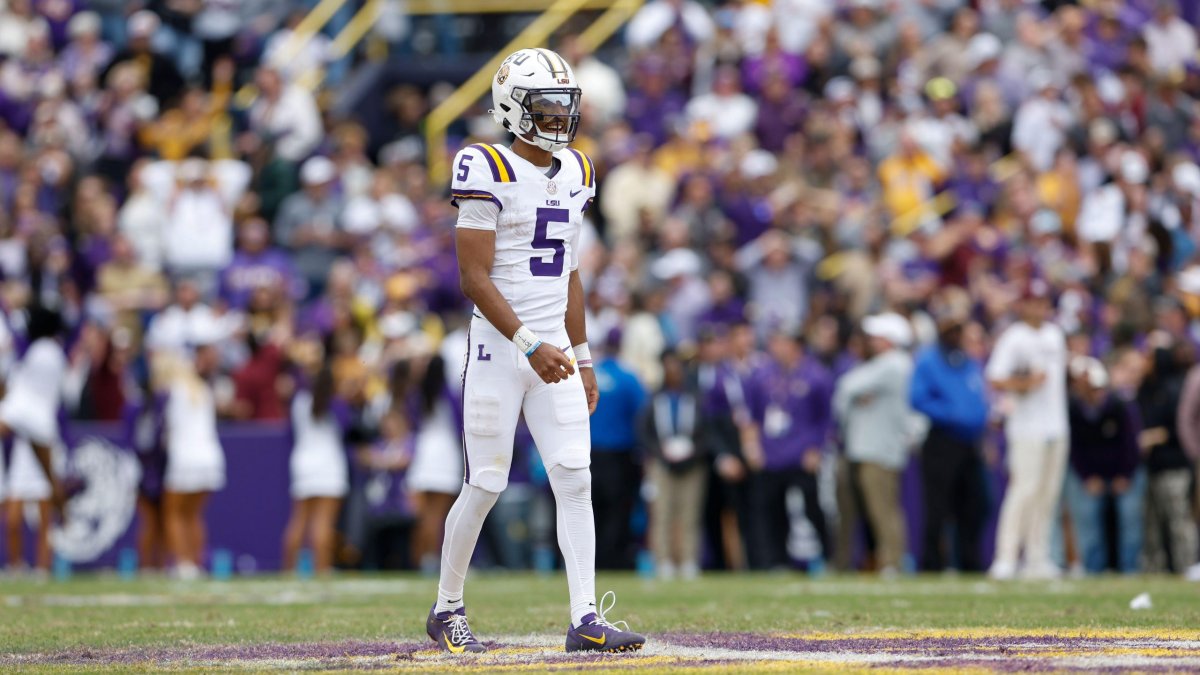• Jayden Daniels' rushing prowess and turnover avoidance compare to Jalen Hurts: Daniels' career trajectory and low-risk passing profile, along with his dynamic legs, make him a safe pick near the top of the draft.
• Cooper DeJean reminds of Trent McDuffie: Both are fundamentally sound players who limit big plays.
• Draft and trade for yourself: Try PFF's Mock Draft Simulator — trade picks and players and mock for your favorite NFL team.
Estimated Reading Time: 9 minutes
Click here for more draft tools:
2024 Mock Draft Simulator | 2024 Big Board | 2024 Draft Guide
2024 Player Profiles | 2024 Mock Drafts | NCAA Premium Stats
Comparing draft prospects to current and past NFL players can be dangerous, as it often sets unrealistic expectations. Regardless, it is fun and they give a good frame of reference for the type of player that each prospect could be.
We’ll examine some of my favorite player comps heading into the 2024 NFL Draft.
QB Jayden Daniels, LSU
Pro Comp: Jalen Hurts
Jayden Daniels’ build and exploits as a runner draw comparisons to Lamar Jackson. While those comparisons are statistically warranted, the appropriate parallel for Daniels as a passer is Philadelphia Eagles quarterback Jalen Hurts.
Like Daniels, Hurts showed promise early in his career at Alabama, playing at least starting-caliber football before extenuating circumstances motivated him to transfer to Oklahoma. Hurts became a superstar for the Sooners, finishing second in the Heisman race and overall grade, behind Joe Burrow.
Most importantly, both quarterbacks are masters at avoiding turnovers, though they don’t carry astronomical big-time throw rates.
| Jayden Daniels | Jalen Hurts | |
| Big Time Throw % | 4.5% | 4.7% |
| Turnover-Worthy Play % | 1.6% | 2.7% |
| Interceptions | 20 | 19 |
Daniels owns the best turnover-worthy play rate of any Power Five quarterback with at least 600 dropbacks since 2014. He’s also on an upward trajectory after nearly tripling his 2.9% big-time throw rate from 2022 this past season.
In a redraft of the 2020 class, Jalen Hurts would likely be selected within the first 12 picks. Daniels' career trajectory and low-risk passing profile, along with his dynamic legs, make him a safe pick near the top of the draft, even if doesn’t quite sustain his excellent big-time throw rate from last season.

RB Bucky Irving, Oregon
Pro Comp: Theo Riddick
Oregon’s Bucky Irving is a tough evaluation. One on hand, he was a dynamic player within one of the nation’s premier offenses for two seasons. On the other, his athletic traits don’t jump off the tape and his running style could be described as more slippery than explosive. His best asset in the immediate future is his receiving ability.
He resembles former Notre Dame running back Theo Riddick, who also was not particularly explosive but did catch the ball very well and made tacklers miss often.
While Riddick’s Notre Dame career predates the PFF College era, he was a productive receiver in the NFL for a half-decade and led the entire league in receiving grade and forced missed tackles as a receiver in 2015. His 93.3 career receiving grade ranks third in PFF history (minimum of 100 targets), behind Christian McCaffrey and Pierre Thomas.
Irving and Riddick have similar athletic profiles and skills, and while Irving is likely a day-three pick due to his lack of explosive tools, he should be an immediate contributor in a league that values receiving backs more than ever.
RB Cody Schrader, Missouri
Pro Comp: Tyler Allgeier
Watching Missouri’s Cody Schrader excel with his hard-charging one-cut running style, slicing through SEC defenses, reminded me of another player who worked hard to earn his keep in college: Tyler Allgeier.
Schrader worked his way to Missouri via Truman State at the D-II level. Allgeier was a walk-on at BYU. By the end of their careers, both players were the unsung engines of explosive offenses, and their final-year statistics are eerily similar.
| Cody Schrader (2023) | Tyler Allgeier (2021) | |
| Rushing Yards | 1,611 | 1,611 |
| Yards Per Carry | 5.81 | 5.86 |
| 10-Plus-Yard Runs | 39 | 40 |
| Rushing Grade | 89.2 | 90.4 |
Both players ran with extreme physicality and posted nearly identical 40 times at the NFL scouting combine. Allgeier is a bit thicker in his lower body, while Schrader succeeded in a Missouri offense that was a bit more scheme-versatile. Their style is generally similar, though, and I wouldn’t be surprised to see Schrader in a similar role as Allgeier has played in Atlanta.
WR Xavier Legette, South Carolina
Pro Comp: DK Metcalf
This comp took a small hit when South Carolina’s Legette measured 2 inches shorter than the 6-foot-3 mark the Gamecocks listed him as. Nonetheless, I’ll stick with it after watching Legette carry their offense this past season and put on an explosive display at the NFL scouting combine that was only microscopically lesser than that of DK Metcalf.
Legette and Metcalf are both blazing fast and very strong but play a linear style without a ton of wiggle at or beyond the line of scrimmage. However, when they get their momentum going, they can be serious threats to score on any play.
While he is 2 inches shorter than Metcalf, Legette has a couple of advantages heading into the draft. We never actually got to see Metcalf have a monster season at Ole Miss. Legette finished 2023 with the eighth-most yards in the country and an 86.9 receiving grade. Legette also owns a better college drop rate than Metcalf.
Metcalf was selected with the final pick in the second round of 2019 and instantly became a productive player in Seattle despite a limited route tree. I expect Legette to land around that spot, or potentially higher, and use his similar skill set to succeed in the NFL.
TE Brock Bowers, Georgia
Pro Comp: George Kittle
This is probably the most common comparison on this list, but it rings too true to ignore. Brock Bowers is arguably the best tight end in college football history. Since 2014, Bowers ranks second among FBS tight ends in yards after the catch and first in yards after contact.
49ers tight end George Kittle is slightly bigger than Bowers but also makes explosive plays after the catch. Kittle ranks third in PFF history in receiving grade and fifth in yards after the catch despite being targeted just 664 times so far in his career. He ranks second behind Jonnu Smith in yards after the catch per reception.
Bowers’ production at Georgia was off the charts, in addition to his post-catch ability. He also gained more than 1,000 yards in his career when lined up in the slot, something elite NFL tight ends are becoming more accustomed to. He could potentially walk into the league as a top-eight player at the position.
T Taliese Fuaga, Oregon State
Pro Comp: Ryan Ramczyk
Joe Alt is almost universally thought of as the best all-around tackle in this draft, but Taliese Fuaga finished 2023 as the nation’s best run blocker by a pretty wide margin. Among Fuaga’s strengths is his elite ability in the zone run game, and I believe he can make an immediate impact like Ryan Ramczyk did in New Orleans.
Over the past two years, Fuaga played the second-most zone run snaps among Power Five tackles and ranked fourth among that same group with an 88.1 run-blocking grade in zone concepts. Only current Browns tackle Dawand Jones was better among primary right tackles.
If Fuaga keeps that up, he could improve a team’s running game in a similar manner to Ramczyk, whose 92.1 zone run-blocking grade since 2017, his draft year, ranks third among right tackles with at least 300 zone reps. His pass protection is closer to above average than elite, but it’s certainly been good enough to succeed in the NFL. A similar result for Fuaga would be ideal.
DI Braden Fiske, Florida State
Pro Comp: Bryan Bresee
Perhaps no prospect has improved their draft stock during the pre-draft process more than Florida State’s Braden Fiske. He demolished every test and drill at the NFL scouting combine and was arguably the best player at the Senior Bowl.
Though they come from vastly different football backgrounds, Fiske most reminded me of current New Orleans Saints defensive tackle Bryan Bresee. Both are incredibly athletic and versatile for their size and can line up all over the defensive line.
Each struggles when blockers use their superior length to control them and create angles in the run game, which could be an issue for Fiske because his 31-inch arms are significantly shorter than Bresee’s. Nevertheless, Bresee offered instant value in New Orleans as a pass rusher, and I would expect Fiske to do the same in the NFL, even if he struggles in the run game at first.
CB Terrion Arnold, Alabama
Pro Comp: L’Jarius Sneed
Terrion Arnold is another player whose draft stock has risen in the past six months. He was allowed more opportunities to make plays in Tuscaloosa while opposing offenses shied away from Kool-Aid McKinstry. He has also dominated the pre-draft process and now seems guaranteed to be a first-round selection.
I was most impressed with Arnold’s sheer aggression and competitive spirit. McKinstry and Cooper DeJean are more technically sound than Arnold, but he makes up for that with a fearless and physical demeanor.
That competitiveness made me think of two-time Super Bowl champion L’Jarius Sneed. Their physical builds are nearly identical. Sneed is just a tick faster, but the two attack the game similarly with inside-outside versatility.
Arnold finished 2023 with a 75.9 grade in the slot while playing more than 200 snaps there. His 90.6 run-defense grade also ranked third among FBS cornerbacks, showcasing his physical nature. Prospective teams will have different ideas for how to use Arnold. Whether it’s inside or outside, his competitiveness and talent will be an asset.

CB Cooper DeJean, Iowa
Pro Comp: Trent McDuffie
File DeJean’s and McDuffie’s college tape into the “so good it’s boring” category. DeJean is slightly bigger and had more ball production in college than McDuffie, but both players play with nearly flawless technique. DeJean showed that on the outside and in the slot while flashing excellent run defense. Since 2019, only four FBS cornerbacks have earned 90.0-plus grades in coverage and run defense — DeJean, McDuffie, Kool-Aid McKinstry and Emmanuel Forbes.
Not only are they versatile, but DeJean and McDuffie posted very similar coverage numbers during their college careers.
| DeJean | McDuffie | |
| Coverage Snaps | 841 | 852 |
| Coverage Grade | 90.4 | 92.0 |
| Yards Allowed Per Target | 5.3 | 5.0 |
| 15-Plus-Yard Receptions Allowed | 8 | 9 |
| Forced Incompletions | 12 | 12 |
Both players simply don’t allow big plays. They are fundamentally sound and make tackles after the catch. McDuffie quickly became a superstar and a first-team All-Pro in 2023. DeJean’s underrated athleticism and pristine technique give him a chance to find similar success.
S Javon Bullard, Georgia
Pro Comp: C.J. Gardner-Johnson
Like Philadelphia’s C.J. Gardner-Johnson, Javon Bullard is a slot/safety who aggressively makes plays on the ball. After playing almost exclusively in the slot during his first two years in Athens, Bullard primarily played safety in 2023 while still logging nearly 150 snaps in the slot, posting an 88.4 coverage grade in the process. This idea may have come about during Georgia’s national title victory over TCU when Bullard had two interceptions — one from the slot and the other while playing a deep-half zone.
Bullard is a naturally aggressive ball hawk from either spot. He can be a bit too aggressive with his tackling angles and overrun ball carriers, but his ball production and infectious attitude make those errors worth looking past. He’s a perfect fit for a team looking for a versatile playmaker who can move around the defensive formation.





 © 2024 PFF - all rights reserved.
© 2024 PFF - all rights reserved.